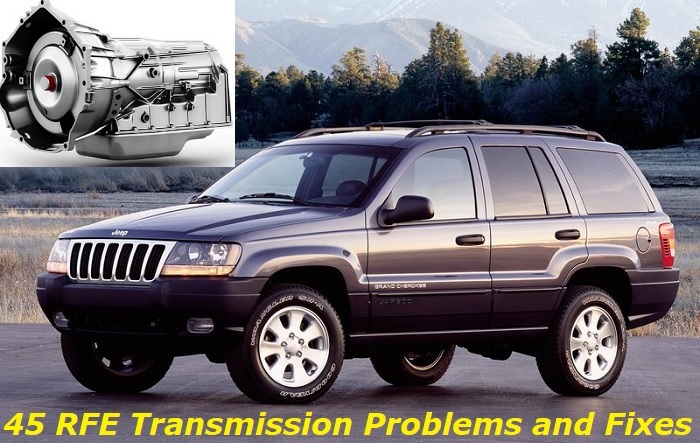The 45RFE was launched in 1999. It was one of the innovative advancements in the new Jeep Grand Cherokee (WJ). At face value, this innovative automatic transmission seemed normal. After all, automakers launch new models with new drivetrains all the time. However, this one wasn't ordinary. What was extraordinary with the 45RFE transmission was the additional two gears.
45RFE transmission highlights
- Average lifespan:220,000-240,000 miles
- Reliability Score:High
- Prone to minor issues:No
- Price for repair after failure:$800-$1,000
- Price for replacement:$2,400-$3,800
- Availability of parts:Good
- Common problems: Fluid pump issues, friction plates burning, solenoids aren't perfect, electronic control problems.

Which Chrysler Cars Use the 45RFE transmission?
The first Chrysler vehicle to apply the 45RFE was the 1999 to 2000 Jeep Grand Cherokee with the 4.7-liter PowerTech V8 engine. Thanks to its solid performance, Chrysler also used the transmission in 2002 to 2003 Jeep Liberty models with the 3.7-liter, 2000 to 2002 4.7-liter Dodge Dakota, and the 3.9-liter Dakota Sport Edition models. 2000 to 2002 Dodge Durango with the 4.7-liter engine and the 2002 Dodge Ram 1500 with the 3.7-liter and 4.7-liter units also used the 45RFE transmission.
How Good Is The 45RFE Transmission?
The 45RFE is a solid transmission. It has survived the test of time to be usable today. Although the newest vehicle to feature this transmission was the 2003 Jeep Liberty, models equipped with the 45RFE are known to be very reliable. This fact can be attested by the fact that despite the many modern transmissions succeeding the 45RFE, drivers still prefer to use it.
It is durable and long-lasting, and thanks to many remanufacturers offering excellent swap units of the 45RFE, you can still buy this transmission and replace your old and tired one. Remanufactured units have all factory defects deleted.
Is the 45RFE Identical Across All Its Applications?
Chrysler designed this transmission for different vehicles, so, it is not the same in every model it is used in. Chrysler must have had a way of modifying the transmission before fitting it into various models. This means that the 45RFE in the 1999 Jeep Grand Cherokee isn't the same as the unit featured in the 2002 Dodge Dakota. The transmission is used on various models equipped with 3.7-liter and 4.7-liter engines.
After noticing the success of the 45RFE, Chrysler introduced the 545RFE to accommodate more vehicles. The 545RFE transmission featured an extra gear. Additionally, the 545RFE's gear ratio differs from that of the 45RFE, resulting in expanded versatility.
45RFE Transmission Shifting Problems
To identify some of the common issues with the 45RFE transmission, we'll take a closer look at the first vehicle to use the 45RFE transmission, the Jeep Grand Cherokee.
When it gets cold, the Grand Cherokee shifts differently. While some people may think it's normal, it is good to note that it is not. The Transmission Control Module is designed to note changes in your vehicle's transmission unit and adjust operations accordingly. If it senses a problem, it'll alter how the transmission works to accommodate the changes. And this may result in issues with your transmission unit.
On the Chrysler 45RFE electronic automatic transmission, the TCM notes the readings on the engine coolant temperature sensor when you power up the vehicle. It then uses these readings as the reference point to estimate the automatic transmission fluid temperature.
Once this is done, the Transmission Control Module updates the estimated ATF fluid temperature - the vehicle is driven based on the speed of the torque converter slip, the speed of the car, the gear position, or the motor coolant temperature.
Suppose the vehicle is being driven normally and has no other underlying issues; the oil temperature estimate will not be far from the actual oil temperature. However, the estimated oil temperature may differ when the transmission is overfilled with ATF fluid or the transmission cooler is restricted. You may also get wrong temperature estimates if you drive aggressively in low gear or the engine overheats.
When these happen, the Transmission Control Module will underestimate the oil temperature, causing it to shift at the wrong points.
The 45RFE uses different shift schedules based on the ATF fluid temperature. These schedules are:
- The Extreme Cold Shift Schedule is when the ATF temperature is -16 degrees F and below. The 45RFE allows Park, Neutral, Reverse, first, and third gears only at this stage.
- The 45RFE uses the Super Cold Shift Schedule when the oil temperature is between -12 degrees and 10 degrees F. This schedule delays the upshift of gears two to three and three to four and allows for early coastdown shifts of gears four to three and three to two. This schedule also restricts high-speed kickdown shifts from four to three, three to two, and two to one.
- The Cold Shift Schedule takes over when the Automatic Transmission Fluid temperature is between 10 and 36 degrees F. In this mode, the 45RFE shifts at higher throttle openings. In the cold shift schedule, high-speed shift kickdown shifts of four to three, three to two, and two to one are still restricted. In these three modes, the torque converter clutch won't lock up.
- When the ATF fluid temperature reaches 40 degrees F and above, the Transmission Control Module switches to the Warm Shift Schedule. At this range, the transmission works normally for upshifts, kickdown, and coastdown shifts but still restricts the torque converter clutch.
- At 80 degrees F, the Transmission Control Module switches to Normal Shift Mode, also called Hot. At this range, the transmission works normally and brings the torque converter clutch lockup on board at speeds above 22 mph.
- When the Automatic Transmission Fluid goes beyond 240 degrees F, generally referred to as too hot, the Overheat Shift Schedule takes over. The engine is overheating at this stage - the coolant is at 244 degrees F. This schedule delays two to three and three to four upshifts and interferes with the torque converter lockup points.
- The last stage is the Super Overheat Shift Schedule which takes over when the ATF fluid temperature reaches 260 degrees F and above. At this point, the fluid is really hot, and nothing is working normally with your 45RFE Chrysler transmission. At this stage, the two to three and three to four gear upshifts are further delayed. Additionally, the torque converter clutch won't unlock at speeds above 22 mph. The only way the torque converter clutch will unlock is when the throttle angle is below 4 degrees, or the driver makes a wide-open throttle kickdown shift from second to the first gear.
As noted from the listed shift schedules, all stages except the hot/ normal shift schedules will cause your vehicle to misbehave. The Automatic Transmission Fluid and engine coolant temperatures can adversely affect how the 45RFE transmission operates. Inputs from engine sensors can also affect the normal functioning of the transmission.
What Causes The 45RFE Transmission Problems?
From the shift schedules discussed above, five stages will cause your Chrysler's transmission to have difficulties functioning normally. That said, are a few reasons.
The 45RFE transmission can engage the overheat or superheat modes:
- If the engine overheats
- When you drive aggressively in low gear
- Suppose you tow a trailer in Overdrive. The third gear is recommended if there's frequent gear shifting.
- If you drive in slow stop-and-go traffic. This will also prompt the TCM to engage the overheat or superheat shift schedules.
- If the engine is idling too fast (stuck Automatic Idle Speed motor)
The Transmission Control Module may employ any cold shift schedule and restrict the torque converter clutch lockup if the indicated motor coolant temperature remains too low for too long. This may be caused by an open thermostat or a low coolant level. A bad coolant sensor will also cause the TCM to engage any of the three cold shift schedules.
Is The 45RFE The Same As the 545RFE transmission?
Shortly after Chrysler launched the 45RFE electronic automatic transmission in 1999, the automaker introduced the 545RFE. This was a slightly advanced version of the 45RFE, and it was meant to stretch the transmission to more vehicles. Besides Jeep and Dodge, the 545RFE added the 2007 to 2009 Chrysler Aspen powered by the 4.7-liter and the 5.7-liter Hemi, and the 2007 LTI/London Taxi Company TX4, which still uses this transmission.
Although these two transmissions are mechanically identical, the software used differs. The 545RFE featured an added electronically-controlled firth gear. Also, their Transmission Control Modules are different.
About the authors
The CarAraC research team is composed of seasoned auto mechanics and automotive industry professionals, including individuals with advanced degrees and certifications in their field. Our team members boast prestigious credentials, reflecting their extensive knowledge and skills. These qualifications include: IMI: Institute of the Motor Industry, ASE-Certified Master Automobile Technicians; Coventry University, Graduate of MA in Automotive Journalism; Politecnico di Torino, Italy, MS Automotive Engineering; Ss. Cyril and Methodius University in Skopje, Mechanical University in Skopje; TOC Automotive College; DHA Suffa University, Department of Mechanical Engineering






Add comment